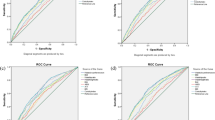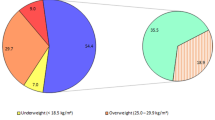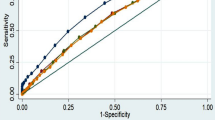Abstract
Objective: To describe body mass index (BMI), waist circumference and waist-hip ratio in a Palestinian West Bank village population, and to assess the associations of these variables to blood pressure and serum lipids.
Design: Cross-sectional study.
Setting: Community-based study in a prototypic semi-rural Palestinian village in the central West Bank.
Subjects: All individuals aged 30–65 y in the study village were invited for the study and 500 (85%) participated.
Main outcome measures: BMI≥30 was used as the measure of obesity.
Results: The prevalence of obesity was 37.5% among women and 18.8% among men. The prevalence of abdominal obesity was 62.5% among women and 14.8% among men. BMI seemed to be the more important correlate of blood pressure whereas waist–hip ratio seemed to be the more important correlate of serum triglycerides, compared to the other obesity measures.
Conclusions: The prevalence of obesity in the study population was very high compared to most other countries in the world, particularly among women.
Sponsorship: The study was funded by the Norwegian Universities' Committee for Development Research (NUFU). LCM Stene was supported by a grant from the Throne Holst Foundation.
European Journal of Clinical Nutrition (2001) 55, 805–811
This is a preview of subscription content, access via your institution
Access options
Subscribe to this journal
Receive 12 print issues and online access
$259.00 per year
only $21.58 per issue
Buy this article
- Purchase on Springer Link
- Instant access to full article PDF
Prices may be subject to local taxes which are calculated during checkout
Similar content being viewed by others
References
Ajlouni K, Jaddou H & Batieha A (1998) Obesity in Jordan Int. J. Obes. Relat. Metab. Disord. 22 624–628
al-Isa AN (1995) Prevalence of obesity among adult Kuwaitis: a cross-sectional study Int. J. Obes. Relat. Metab. Disord. 19 431–433
al-Nuaim A, Al-Rubeaan K, Al-Mazrou Y, Khoja T, Al-Attas O & Al-Daghari N (1996a) Prevalence of diabetes mellitus, obesity and hypercholesterolemia in Saudi Arabia. In Diet Related Non-communicable Diseases in the Arab Countries of the Gulf, eds. AO Musaiger & SS Miladi 73–81 Cairo: FAO/RNE
al-Nuaim AR, Al-Rubeaan K, Al-Mazrou Y, Al-Attas O, Al-Daghari N & Khoja T (1996b) High prevalence of overweight and obesity in Saudi Arabia Int. J. Obes. Relat. Metab. Disord. 20 547–552
al-Rehaimi AA & Björntorp P (1992) Obesity and fat distribution in women from Saudi Arabia Int. J. Obes. Relat. Metab. Disord. 16 1017–1019
Altman DG (1991) Practical Statistic for Medical Research London: Chapman & Hall
Alwan A & King H (1992) Diabetes in the Eastern Mediterranean region World Health Stat. Q. 45 355–359
Barker DJP (1998) Mothers, Babies and Health in Later Life Edinburgh: Churchill Livingstone
Björntorp P (1988) The association between obesity, adipose tissue distribution and disease Acta Med. Scand. 723 (Suppl), 121–134
Folsom AR, Li Y, Rao X, Cen R, Zhang K, Liu X, He L, Irving S & Dennis BH (1994) Body mass, fat distribution and cardiovascular risk factors in a lean population of south China J. Clin. Epidemiol. 47 173–181
Giacaman R (1988) Life and Health in Three Palestinian Villages. Jerusalem studies series No. 14. London: Ithaca Press
Herman WH, Ali MA, Aubert RE, Engelgau MM, Kenny SJ, Gunter EW, Malarcher AM, Brechner RJ, Wetterhall SF & DeStefano F (1995) Diabetes mellitus in Egypt: risk factors and prevalence Diabetic Med. 12 1126–1131
Hodge AM, Dowse GK, Gareeboo H, Tuomilehto J, Alberti KG & Zimmet PZ (1996) Incidence, increasing prevalence, and predictors of change in obesity and fat distribution over 5 y in the rapidly developing population of Mauritius Int. J. Obes. Relat. Metab. Disord. 20 137–146
Husseini A, Abdul-Rahim H, Awartani F, Giacaman R, Jervell J & Bjertness E (2000) Type 2 diabetes mellitus, impaired glucose tolerance, and associated factors in a rural Palestinian village Diabetic Med. 17 746–748
Keenan NL, Strogatz DS, James SA, Ammerman AS & Rice BL (1992) Distribution and correlates of waist-to-hip ratio in black adults: the Pitt county study Am. J. Epidemiol. 135 678–684
Kuczmarski RJ, Flegal KM, Campbell SM & Johnson CL (1994) Increasing prevalence of overweight among US adults. The National Health and Nutrition Examination Surveys, 1960 to 1991. J.A.M.A. 272 205–211
Kuskowska-Wolk A & Bergström R (1993) Trends in body mass index and prevalence of obesity in Swedish women 1980–89 J. Epidemiol. Community Health 47 195–199
Lapidus L, Bengtsson C, Larsson B, Pennert K, Rybo E & Sjostrom L (1984) Distribution of adipose tissue and risk of cardiovascular disease and death: a 12 y follow up of participants in the population study of women in Gothenburgh, Sweden Br. Med. J. 289 1257–1261
Lean ME, Han TS & Morrison CE (1995) Waist circumference as a measure for indicating need for weight management Br. Med. J. 311 158–161
Manson J, Willett W, Stampfer M, Colditz G, Hunter DJ, Hankinson SE, Hennekens CH & Speizer FE (1995) Body weight and mortality among women New Engl. J. Med. 333 677–685
Modan M, Karasik A, Halkin H, Fuchs Z, Lusky A, Shitrit A & Modan B (1986) Effect of past and concurrent body mass index on prevalence of glucose intolerance and type 2 (non-insulin-dependent) diabetes and insulin response Diabetologia 29 82–89
Molarius A & Seidell JC (1998) Selection of anthropometric indicators for classification of abdominal fatness—a critical review Int. J. Obes. Relat. Metab. Disord. 22 719–727
Molarius A, Seidell JC, Sans S, Tuomilehto J & Kuulasmaa K (1999) Waist and hip circumferences, and waist–hip ratio in 19 populations of the WHO MONICA project Int. J. Obes. Relat. Metab. Disord. 23 116–125
Monteiro CA, Mondini L, Medeiros de Souza AL & Popkin BM (1995) The nutrition transition in Brazil Eur. J. Clin. Nutr. 49 105–113
Musaiger AO (1996) Trends in diet-related chronic diseases in United Arab Emirates. In Diet Related Non-communicable Diseases in the Arab countries of the Gulf, eds. AO Musaiger& SS Miladi 99–117 Cairo: FAO/RNE
Musaiger AO & Miladi SS, eds (1996) Diet-related Non-communicable Diseases in the Arab Countries of the Gulf Cairo: FAO/RNE
Onat A & Sansoy V (1998) Systolic and diastolic blood pressure related to six other risk parameters in Turkish adults: strong correlation with relative weight Int. J. Cardiol. 63 295–303
Pishdad GR (1996) Overweight and obesity in adults aged 20–74 in southern Iran Int. J. Obes. Relat. Metab. Disord. 20 963–965
Popkin BM (1994) The nutrition transition in low-income countries: an emerging crisis Nutr. Rev. 52 285–298
Popkin BM, Paeratakul S, Ge K & Zhai F (1995) Body weight patterns among the Chinese: results from the 1989 and 1991 China Health and Nutrition Surveys Am. J. Public Health 85 690–694
Prentice AM & Jebb SA (1995) Obesity in Britain: gluttony or sloth? Br. Med. J. 311 437–439
Stene LCM, Giacaman R, Abdul-Rahim H, Husseini A, Norum KR & Holmboe-Ottesen G (1999) Food consumption patterns in a Palestinian West Bank population Eur. J. Clin. Nutr. 53 953–958
WHO (1995) Physical Status: the Use and Interpretation of Anthropometry. Technical Report Series no. 854. Geneva: World Health Organization
WHO (1996) World Health Statistics Annual 1995 Geneva: World Health Organization
Acknowledgements
The study was funded by the Norwegian Universities' Committee for Development Research (NUFU). LCM Stene was supported by a grant from Throne Holst Foundation. We would like to thank Jinan Bargouthi and Amy Schmidt for their discussions and help with data entry.
Author information
Authors and Affiliations
Corresponding author
Rights and permissions
About this article
Cite this article
Stene, L., Giacaman, R., Abdul-Rahim, H. et al. Obesity and associated factors in a Palestinian West Bank village population. Eur J Clin Nutr 55, 805–811 (2001). https://doi.org/10.1038/sj.ejcn.1601230
Received:
Revised:
Accepted:
Published:
Issue Date:
DOI: https://doi.org/10.1038/sj.ejcn.1601230
Keywords
This article is cited by
-
Prevalence of underweight, overweight and obesity among Palestinian school-age children and the associated risk factors: a cross sectional study
BMC Pediatrics (2019)
-
Prevalence of obesity and associated risk factors among adults in Kinondoni municipal district, Dar es Salaam Tanzania
BMC Public Health (2011)
-
Prevalence of metabolic syndrome-related disorders in a large adult population in Turkey
BMC Public Health (2006)
-
Prevalence of Obesity and Associated Risk Factors in a Turkish Population (Trabzon City, Turkey)
Obesity Research (2004)
-
Obesity in a rural and an urban Palestinian West Bank population
International Journal of Obesity (2003)



